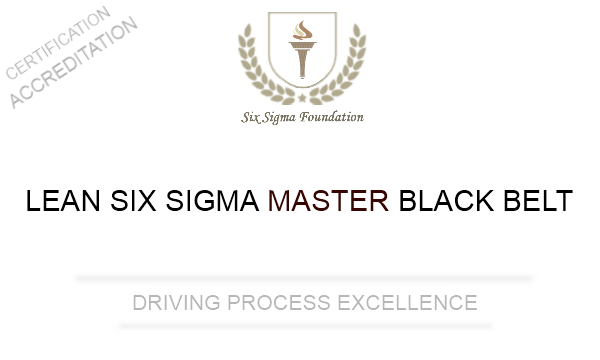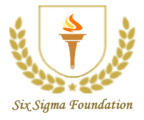Lean Six Sigma Master Black Belt - Body of Knowledge

SSF Lean Six Sigma Master Black Belt - BOK
The minimum recommended Body of Knowledge that any ATI needs to be compliant with for Accreditation with the SSF Lean Six Sigma Master Black Belt Certification Level. Our unique approach to the BOK was designed as a necessary requirement to our equally unique approach of validating SSF ATI’s certification exams to democratize Accredited Lean Six Sigma Certifications by reducing Organizational training costs to create competent people resources. Refer BOK sections in brief or download composite pdf with all details below.

SSF Lean Six Sigma Master Black Belt Certification: Exam Focus Areas
Exam focus areas are those from where questions are deemed mandatory, so as to ascertain a student's comprehension for key (and minimal) expected knowledge areas along with demonstrable practical ability in order to attain a SSF Lean Six Sigma Master Black Belt Certification from a SSF Accredited Training Institute. This is a less exhaustive list than the Curriculum Focus Area list and is designed primarily to serve as a basic-guideline to validate the exam questionnaires as per SSF norms. On the whole though, the examination system and methodology for SSF ATIs is another area which gets validated separately for accreditation purposes by SSF, which Includes the online examination mechanism, proctoring controls, as well as the Bloom's Taxonomy (cognitive domain) Level expected to be evaluated in an objective manner in addition to the Exam Focus areas (and weightage of questions). Additionally an expected/mandatory requirement for an LSSMBB level is a project evaluation to be done by the ATI to validate a student's ability in a simulated/real work environment to demonstrate his/her competency (unassisted by any mentor) post the examination process. For LSSMBB Certification candidates must clear the exam as well as project evaluation independently. And as certification by itself is inherently a grading, therefore only a non-mandatory guideline for calculating an overall score/grade is proposed here, should the ATI's need the same for any further academic purposes; in such a case they may consider the exam weightage as 70% and practicals weightage (project evaluation) as 30%.
Focus Areas (Exam): Lean
Mandatory Question Areas: Lean Enterprise and Hoshin Kanri, Concepts of continuous improvements (PDCA, Kaizen), Kanban and Heijunka Techniques.
Overall Area weightage: 15% (For Exam)
Bloom’s Taxonomy (2001 revision) Level: Analyze (Maximum Targeted Level for this Area)
Focus Areas (Exam): Business Excellence
Mandatory Question Areas: Enterprise Change Management Methodologies, BPM, Decision Resolution Tools, Balanced Scorecard
Overall Area weightage: 15% (For Exam)
Bloom’s Taxonomy (2001 revision) Level: Analyze (Maximum Targeted Level for this Area)
Mandatory Question Areas: Financial Management Metrics (ROI, NPV, IRR etc.)
Overall Area weightage: 15% (For Exam)
Bloom’s Taxonomy (2001 revision) Level: Evaluate (Maximum Targeted Level for this Area)
Mandatory Question Areas: Project Selection Considerations, Concepts from Contemporary Project Management Methodologies, Group Dynamics, Project Monitoring
Overall Area weightage: 10% (For Exam)
Bloom’s Taxonomy (2001 revision) Level: Evaluate (Maximum Targeted Level for this Area)
Mandatory Question Areas: QFD, DFSS, RPA
Overall Area weightage: 15% (For Exam)
Bloom’s Taxonomy (2001 revision) Level: Evaluate (Maximum Targeted Level for this Area)
Focus Areas (Exam): Core Stats and Six Sigma
Mandatory Question Areas: Gage R&R, Hypothesis Test Selection, Multi-Vari Analysis, Control Charts Selection (including CUSUM and EWMA).
Overall Area weightage: 15% (For Exam)
Bloom’s Taxonomy (2001 revision) Level: Evaluate (Maximum Targeted Level for this Area)
Mandatory Question Areas: Predictive Analytics with Multiple Regression, Logit Model, Time-Series; Advanced DOE concepts and designs like Taguchi Methods, Response Surface, Balanced vs Unbalanced designs.
Overall Area weightage: 15% (For Exam)
Bloom’s Taxonomy (2001 revision) Level: Evaluate (Maximum Targeted Level for this Area)
Focus Areas (Practicals): Project Evaluation (mandatory for certification; may weigh in for overall grade)
Key Evaluation Areas: Clarity in Business Objectives (SMART approach for Goals), Scoping Clarity, Stakeholder Management (Communication Planning), Detailed WBS for Scheduling, Risk Analysis, Rationale for choosing project, Expected Benefits relating to Product/Process Quality, Customer-Issues and Financial Impact.
Overall Area weightage: 20% (For Practicals)
Bloom’s Taxonomy (2001 revision) Level: Create (Maximum Targeted Level for this Area)
Key Evaluation Areas: Non Mandatory (but good to have): Documenting current process with detailed SIPOC, Flowchart or VA/NVA Analysis. Use of any supporting analysis employing simple Descriptive Analysis tools and Visual Plots (like Pareto, Scatter Charts etc.) demonstrated/used in the project.
Key Evaluation Areas: Mandatory: MSA (Measurement System Analysis) evaluation, Benchmarks for existing process in terms of Sigma Level, Yield etc.; Data Collection Planning with Data Points/Records and linking to Business Objectives. Evaluate appropriate Normality/Non-Normality considerations for Data. The analysis and improvement phases must demonstrate/employ both Qualitative Analysis/Techniques (like Ishikawa diagrams, Brainstorming, TRIZ etc.) and Quantitative Analysis (Inferential Statistics such as use of hypothesis testing and statistically significance inferences). If Experimentation (DOE) is used then its rationale, execution and recommendations (DOE) needs to be presented with clarity and all the support data and charts. SPC via Control Charts and Response Planning.
Note: The ATI needs to keep in sharp focus that the express purpose of the project evaluation, is to check for the ability of a candidate to achieve a proper solution to a problem rather than usage of tools and plots alone. However, use of software is recommended for visualizations and proper visualization is a bonus.
Overall Area weightage: 60% (For Practicals)
Bloom’s Taxonomy (2001 revision) Level: Create (Maximum Targeted Level for this Area)
Key Evaluation Areas: Final Project Reporting and Documentation Clarity. Proper Data Visualization is a must (can use tools like Excel, Minitab, Tableau etc.). Presentation to Management and/or ATI facilitator with clarity on recommendations and Business Impacts. Discuss Lessons Learnt, what could have been done better etc. and Project Closure report with updation of SOPs (Standard Operating Procedures) linked to the project if possible.
Overall Area weightage: 20% (For Practicals)
Bloom’s Taxonomy (2001 revision) Level: Create (Maximum Targeted Level for this Area)

SSF Lean Six Sigma Master Black Belt Certification: Curriculum Focus Areas
The List of recommended (essential) topics to be covered as part of an SSF ATI's Lean Six Sigma Master Black Belt certification training curriculum.
Focus Areas: Lean
Lean
- How Lean and Six Sigma Work together
- Lean Enterprise and models like Hoshin Kanri etc.
- TOC (Theory of Constraints)
- 5S with Audits (explore Non-SPC control mechanisms)
- Kaizen, PDCA cycle and concepts of continuous improvements
- Gemba
- Kanban
- Heijunka Techniques
- Poka-Yoke
- Metrics in Lean
- VA/NVA Analysis
Focus Areas: Business Excellence
Strategic Thinking
- Strategic Capability Assessment/Planning and use of Business Intelligence, Process Mining, BPM etc.
- Enterprise Change Management Methodologies (Leading Change, Agile Strategy)
- Process Action Groups and Best Practices
- Business Management Basics and Optimizing Resources (People, Finances, Equipment, Operations), Balanced Scorecard
- Decision Resolution with Prioritization: Tools like SWOT, Cost-Benefit, Weighted Criteria Matrices, Decision Trees, Cost-of-Delay, Kano Model
- Linking Business Goals to Projects
- Customer Support/Service Models (Effective Communication/Response/Resolution Mechanisms)
Financial Management
- Financial Management Basics and Objectives
- Financial Management Metrics (ROI, NPV, IRR etc.)
- Financial Control Best Practices (use best practices from SOX)
- Risk Analysis and Monte-Carlo Simulations
Project Management
- Project Selection Considerations
- Concepts from Contemporary Project Management Methodologies (PMI’s approach etc.)
- Risk Plans and Taxonomies
- Group Dynamics and Leadership Models
- Mentoring Techniques
- Stakeholder Communication/Management
- Project Monitoring and Project Support (with customer Issue Resolution Mechanisms and Best Practices)
Problem Solving
- Creative Thinking Techniques: Six Hats, Mind-Mapping, TRIZ
- QFD
- DFSS Approach with focus on Robustness and Reliability
- Digital Transformation and the role of RPA (with use of tools like UiPath etc.)
Focus Areas: Core Stats and Six Sigma
DMAIC
- SIPOC Analysis and Flowcharts
- Project Charter Development
- Measurement System Analysis
- Data Collection Plan
- Baselining Process Performance: Capability and Levels, Sigma Levels and Yield with related Metrics
- Hypothesis Tests selection
- Hypothesis testing on Normal data with common tests
- Hypothesis testing on Non-Normal data with common tests
- Contingency tables and using Chi-Square test
Advanced Data Analysis
- Regression Analysis in Detail (Linear, Quadratic, Exponential)
- Multiple Regression
- Logistical Regression
- Time-Series
- Multi-Vari Analysis
- DOE: Full vs Fractional vs PB designs
- DOE: Taguchi Methods, Response Surface, Balanced vs Unbalanced designs
- Control Charts selection and rules for process stability
- CUSUM and EWMA Charts
Download composite BOK for SSF Lean Six Sigma Master Black Belt as a pdf reference.
